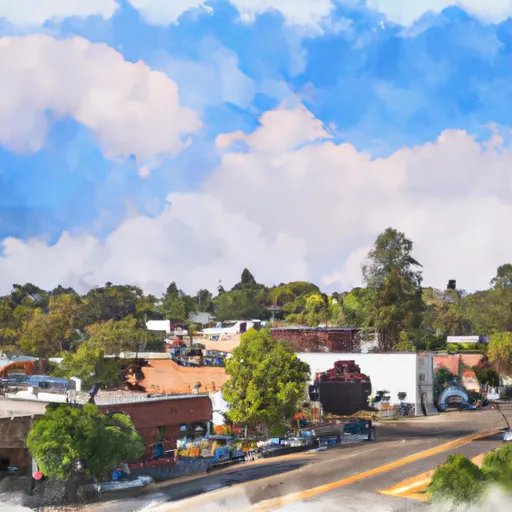-
 Snoflo Premium
Snoflo Premium
Get unlimited access to all our content
With no Ad interruptions! - Start Your Free Trial Login with existing account
Loomis
Eden Index
Climate
9.6
•
Recreation
5.1
•
Community
5.2
•
Safeguard
6.9/10

Loomis, California is a small town located in Placer County, in the foothills of the Sierra Nevada Mountains. The town experiences a Mediterranean climate, characterized by hot, dry summers and mild, wet winters. Summers are typically sunny and warm, with temperatures reaching the high 90s (Fahrenheit), while winters are cooler and wetter, with temperatures averaging around the 50s.
Hydrologically, Loomis is situated near the American River, which flows through the nearby Auburn State Recreation Area. This area offers several outdoor recreational opportunities, such as fishing, boating, and white-water rafting. The American River is renowned for its superb recreational gold panning as well. Additionally, the nearby Folsom Lake provides opportunities for swimming, sailing, and jet skiing.
Apart from water-based activities, Loomis also boasts numerous hiking and biking trails in the surrounding hills and mountains. The popular Hidden Falls Regional Park offers scenic trails that lead to breathtaking waterfalls, making it a favorite spot for outdoor enthusiasts.
Overall, Loomis, California, with its pleasant climate, proximity to the American River, and various outdoor recreation opportunities, attracts nature lovers and adventure seekers throughout the year.
What is the Eden Index?
The Snoflo Eden Index serves as a comprehensive rating system for regions, evaluating their desirability through a holistic assessment of climate health, outdoor recreation opportunities, and natural disaster risk, acknowledging the profound impact of these factors on livability and well-being.
Climate Health Indicator (CHI): 9.6
Loomis receives approximately
652mm of rain per year,
with humidity levels near 78%
and air temperatures averaging around
17°C.
Loomis has a plant hardyness factor of
9, meaning
plants and agriculture in this region tend to thrive here all year round.
By considering the ideal temperature range, reliable water supplies, clean air, and stable seasonal rain or snowpacks, the Climate Health Indicator (CHI) underscores the significance of a healthy climate as the foundation for quality living.
A healthy climate is paramount for ensuring a high quality of life and livability in a region, fostering both physical well-being and environmental harmony. This can be characterized by ideal temperatures, reliable access to water supplies, clean air, and consistent seasonal rain or snowpacks.
Weather Forecast
Streamflow Conditions
Lower Sacramento
Area Rivers
Lower Sacramento
Snowpack Depths
Lower Sacramento
Reservoir Storage Capacity
Lower Sacramento
Groundwater Levels
Recreational Opportunity Index (ROI): 5.1
The Recreational Opportunity Index (ROI) recognizes the value of outdoor recreational options, such as parks, hiking trails, camping sites, and fishing spots, while acknowledging that climate plays a pivotal role in ensuring the comfort and consistency of these experiences.
Access to outdoor recreational opportunities, encompassing activities such as parks, hiking, camping, and fishing, is crucial for overall well-being, and the climate plays a pivotal role in enabling and enhancing these experiences, ensuring that individuals can engage in nature-based activities comfortably and consistently.
Camping Areas
| Campground | Campsites | Reservations | Toilets | Showers | Elevation |
|---|---|---|---|---|---|
| Bear River County Park | 23 | 1,749 ft | |||
| Beale AFB Military | None | 155 ft | |||
| Beals Point - Folsom Lake State Rec Area | 69 | 486 ft | |||
| Nevada County Fairgrounds | None | 2,455 ft | |||
| Peninsula - Folsom Lake State Rec Area | 100 | 792 ft | |||
| Placer County Fair RV | None | 163 ft |
Nearby Ski Areas
Catastrophe Safeguard Index (CSI):
The Catastrophe Safeguard Index (CSI) recognizes that natural disaster risk, encompassing floods, fires, hurricanes, and tornadoes, can drastically affect safety and the overall appeal of an area.
The level of natural disaster risk in a region significantly affects safety and the overall livability, with climate change amplifying these risks by potentially increasing the frequency and intensity of events like floods, fires, hurricanes, and tornadoes, thereby posing substantial challenges to community resilience and well-being.
Community Resilience Indicator (CRI): 5.2
The Community Resilience Indicator (CRI) recognizes that education, healthcare, and socioeconomics are crucial to the well-being of a region. The CRI acknowledges the profound impact of these elements on residents' overall quality of life. By evaluating educational resources, healthcare accessibility, and economic inclusivity, the index captures the essential aspects that contribute to a thriving community, fostering resident satisfaction, equity, and social cohesion.

